Time to Build

Rabbi Dovid Hofstedter has seen his once-mocked program transformed into a global Torah force that operates on a scale that no one could have imagined
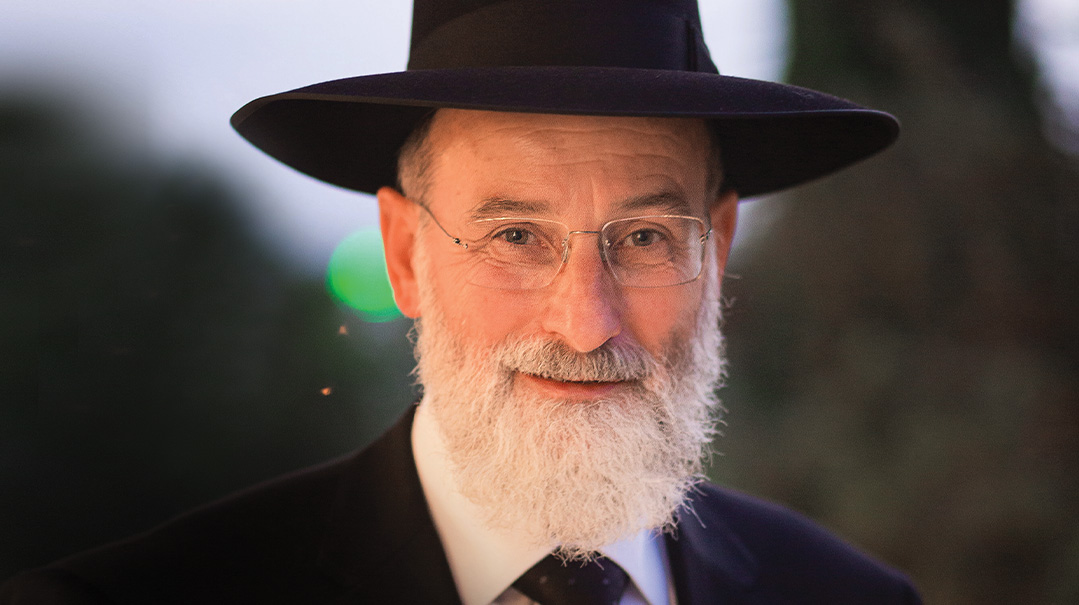
Photos Elchanan Kotler, Family archives
Yom Kippur was little more than a day away, and the atmosphere in the Yerushalayim shul was a mix of serious introspection and pre–Yom Tov bustle when Rabbi Dovid Hofstedter came across an old friend.
As the Dirshu founder entered in search of a Minchah minyan, there was a murmur in the background. Some of the avreichim had recognized the visitor. One or two nudged each other, but most kept to themselves.
Then one man — a friendly, ginger-headed avreich — stepped forward.
“Shalom aleichem,” he greeted the guest warmly, and Rabbi Hofstedter responded in kind. Clearly, there was history between the two.
It turned out that the friendship between the kollel student and the wealthy funder of a massive Torah enterprise began with money — just not in the way one would expect.
“It was Yamim Noraim a few years ago,” Rabbi Hofstedter recalled, “and due to the annual cycle of the real estate market, with taxes needing to be paid by September, plus my Dirshu commitments, I was debating whether to buy myself an aliyah. It’s important, but things were tight.”
He smiles before delivering the punch line.
“Then this avreich stepped forward and bought me an aliyah — I’ve been grateful to him ever since.”
Amusing as it is to think of the kollel avreich riding to the tycoon’s rescue, that little encounter encapsulates the phenomenon known as Reb Dovid Hofstedter.
As founder and funder of Dirshu, he’s channeled the proceeds of a successful real estate business into an industrial-scale Torah revolution.
His programs have produced large numbers of lomdim proficient in Shas; hundreds of dayanim; and tens of thousands worldwide achieving mastery of halachah. The underlying innovations — rigorous testing in exchange for stipends — have ensured that Dirshu has become a universal symbol in a global Torah world.
But after a quarter-century of Torah entrepreneurship, Reb Dovid retains the same self-discipline and laser-focus; he’s a multimillionaire who thinks twice about buying an aliyah when the money could fund another shiur.
It’s probably not a stretch to trace a parallel between his commercial success and his approach to institutional building: both require the ability to identify an area in need of regeneration and marshal the resources to offer a solution.
That would be to overthink things, though.
The real secret of Rabbi Hofstedter’s revolution is that, despite his reserved nature, there is no great secret. What you see is very much what you’ll get. His stump speech at a Dirshu event in Paris is largely what you’ll hear when he opens a landmark real estate development in downtown Toronto.
The same drive to build, the same message of responsibility for the Torah world, the same search for authenticity.
They’re the profound lessons that he learned from his parents, Holocaust survivors who started again in a strange country and didn’t stop building.
“I’m in awe of my parents’ generation,” he says, as his father Sandy Hofstedter’s first yahrtzeit approaches. “They were a generation of survivors whom lived not just to make money but for a higher purpose.”
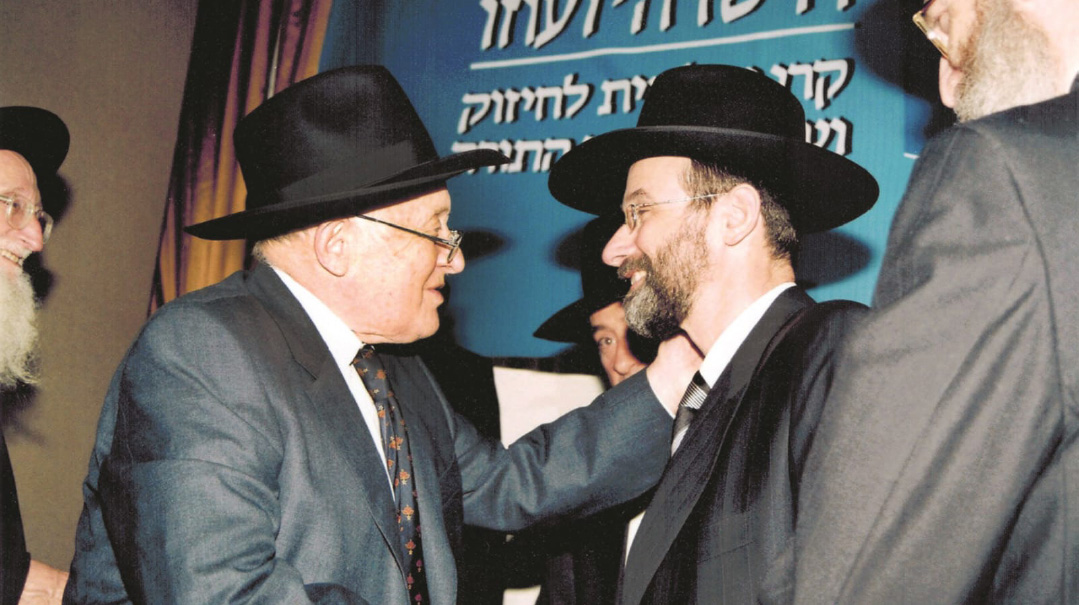
“I’m in awe of my parents’ generation.” Sandy Hofstedter (left) inspired a revolution, which began with one shiur in Reb Dovid’s downtown Toronto office
Making the Cut
The latent Hofstedter entrepreneurial genes first revealed themselves far from the Toronto real estate scene, in the precarious setting of a post-World War II DP camp.
“My father Reb Nosson Nota Yitzchok was born in 1924, in Mezokovesd, a small town in northern Hungary, to Reb Zev (Willy) and Matel Hofstedter,” Rabbi Hofstedter says.
“The family were of mixed Hungarian-Galician ancestry, and my father received a thorough Hungarian-style yeshivah education. Rav Shmiel Schwartz, rosh yeshivah of Kasho, made a big impression. Following the minhag of the Chasam Sofer, he began his daily Gemara shiur with a few minutes of Chovos Halevavos, which would inevitably involve him crying.”
During the war Sandy Hofstedter served in a labor battalion, and after a forced march toward the war’s end, he was sent to Mauthausen.
Surviving the destruction of Hungarian Jewry, he ended up back home, where he met another local survivor. Kicsi (Chaya Sara) Schwartz hailed from Sentosh-Van, a tiny village in the Hungarian countryside. The village was so small that it didn’t even boast a daily minyan. On Shabbos, bochurim would come from a neighboring town to help out.
Education opportunities were also nonexistent — there wasn’t even a school.
“What my mother knew, she learned from her mother and grandmother,” says Reb Dovid. “She internalized that chinuch so well that even when she was starving in Auschwitz, she refused to eat the bread on Pesach.”
Kicsi was part of a group of girls who encouraged each other and at risk to their lives, hid their bread until after Pesach, surviving on the watery “soup” that was the only other sustenance.
The fear and hunger they endured for a mitzvah paid off immediately, though. Shortly after that Pesach, the girls were taken on a death march toward Feldafing, Germany. There was no food, but the girls were able to fend off the exhaustion and starvation that killed so many others by eating the bread that they’d saved.
The fierce commitment to mesorah that the couple shared would stand the family in good stead in postwar Toronto, but first, the way that they arrived there was a testament to Sandy’s quick thinking.
“My parents lived for three years after the war in a DP camp in Turin, Italy. One day in 1948, a Canadian trade representative came looking for skilled manpower for the fur trade, which was then a significant employer.
“My father wasn’t a furrier — the family business before the war was wine — but he was bright, resourceful, and energetic, and he spied an opportunity to get to a good country.
“So, he told the commissioner that he had experience. The most he’d done was cut leather earlier in the war and work in a camp kitchen. But when they gave him a piece of fur to cut, he made the grade.”
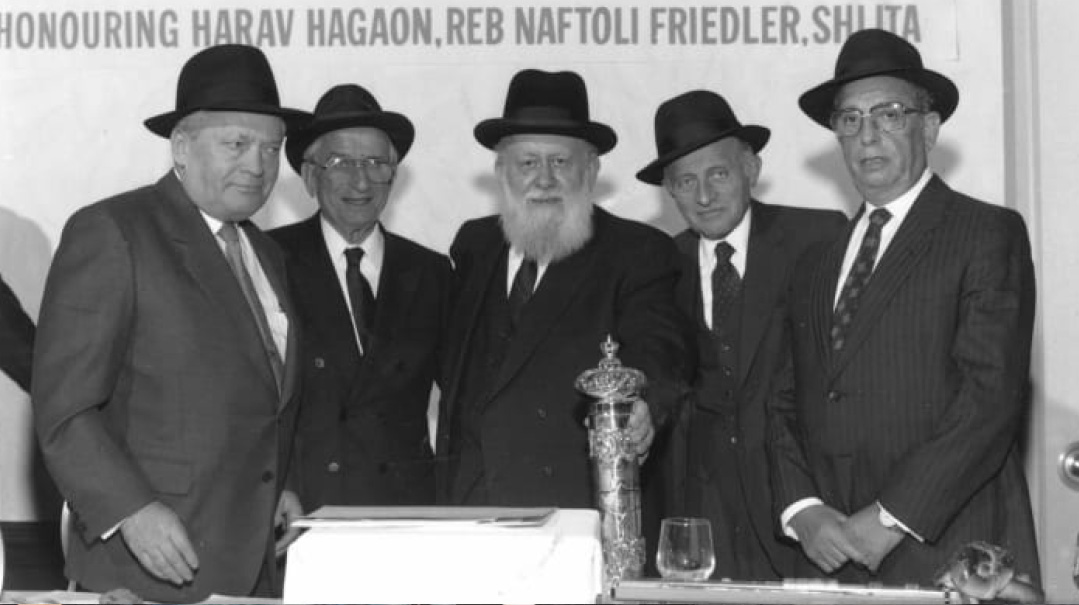
Ner Israel Rosh Yeshiva Rav Naftoli Friedler flanked by Sandy Hofstedter (far left) and the Hofstedters’ mechutan Reb Avrum Bleeman (far-right).
Big Break
Toronto in the 1950s was something of a Little Hungary, due to the concentration of immigrants, both Jewish and non-Jewish, who hailed from that country.
Those early years were a struggle. Sandy and his paternal uncles, who’d also survived the war, would load the car with their furs and go to rural areas outside Toronto, where there was a large concentration of Hungarian immigrants who came after 1956 after the Communists had crushed that year’s uprising.
Like immigrants everywhere, the Hofstedters were determined to pull themselves up by their bootstraps, despite the slim pickings in the “shmatteh business.”
But then came a trauma that forced Sandy to change direction.
“One Sunday afternoon, as my father drove on the highway, someone flagged him down, and when my father stopped to help, the man pulled a gun and demanded his money.”
The loss cleaned out Sandy Hofstedter of his hard-won earnings. But coming so soon after the war, with its terrible memories of men with guns, the hold-up was a trauma that he couldn’t deal with. “He decided that it was time for a career change, and that brought him to real estate.”
The new direction wouldn’t just bring in vast wealth; it opened the door to communal activism that is now in its second generation.
“In the late 50s it was easy to get into the real estate business, because as Canada grew, the banks were lending. There were loans available from Jewish organizations, and my father learned real estate the same way he’d learned the fur business — hands on.”
To qualify for loans, you needed a co-signatory, and Sandy Hofstedter turned to an Orthodox man called Meyer Lebovic. The latter was happy to help get the young Hungarian immigrant on his feet, and he signed as a guarantor to found what eventually became H&R Developments, a multimillion-dollar real estate firm.
That success was still a long way in the future when Meyer Lebovic himself asked Mr. Hofstedter to do him a reciprocal favor. The former wanted to found a yeshivah high school in the city to cater to the large Jewish population.
Meyer Lebovic told Sandy Hofstedter that signing was a formality — he needed to be able to show support, but fundraising responsibility would devolve on Lebovic himself.
A year later, the high school project that became Ner Israel — an independent branch of the Baltimore yeshivah — was a reality.
But then disaster struck: Meyer Lebovic had a heart attack. The doctors prescribed strict quarantine for the recovering patient, and suddenly responsibility devolved on the hitherto “silent partner,” Sandy Hofstedter.
“It all fell on him in the early 60s, when he was just finding his feet in real estate,” says Rabbi Hofstedter. “He was working round the clock to try and provide for his young family, and the role meant far more than just fundraising. People would call and complain about their children’s education or the school meals, and he’d have to convince skeptical mothers that the children were getting a good education.
“But he was a baal achrayus, and he never looked back.”
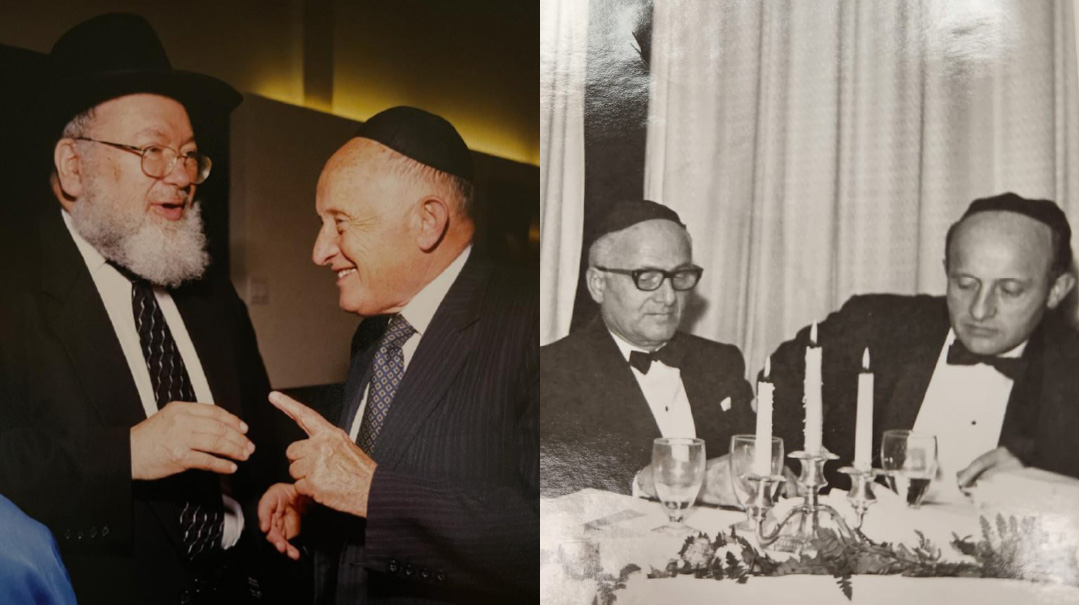
With Rabbi Kerzner of Clinton Park Shul (left); and at a Ner Israel dinner (right)
Keeping It Real
When David — third of four children — was born in 1955, the Hofstedters were still in a precarious financial situation, and the spiritual horizon also left a lot to be desired.
“I don’t speak Hungarian, but I grew up surrounded by conversations between Hungarian immigrants that I didn’t understand. Most of my parents’ contemporaries, though, didn’t remain frum. Only about twenty percent of pupils in my day school were from shomer Shabbos homes. People were very vulnerable after the war.”
It was the Hofstedters’ erlichkeit — their genuine sense of conviction about their beliefs — says their son, that set them apart. “My parents had a real sense of purpose — they weren’t frum to impress anyone.”
Toronto of those early days was off the beaten track of the yeshivah revolution happening south of the border. Later in life, and especially as Dirshu took off, Reb Dovid began consulting what amounted to the mizrach wall of the contemporary Torah world. But his formative experience — what stoked the initial fire and ultimately led to Dirshu — was his parents’ dedication to Jewish life.
Other influences came later in yeshivah, in the Ner Israel that his father gave his heart and soul for. From there he went to Eretz Yisrael, where he learned in Beis HaTalmud under Rav Dov Schwartzman. He would later return to America to learn in Lakewood and marry another Torontonian — Shifra, daughter of Reb Avrum Bleeman, Sandy Hofstedter’s erstwhile fundraising collaborator on behalf of Ner Israel.
But what became clear was that Eretz Yisrael — particularly the struggles of its bnei Torah — had captured his heart.
After their marriage, the young Hofstedters decided to move to Israel, and blend in as much as possible. It was a steep material drop; both the Hofstedters and Bleemans lived comfortable lives, and 1980s Israel was a far cry from what they’d left behind. That, though, was the point.
“We decided not to live as Americans, but as Israelis. We moved to a small Jewish Agency apartment in Sanhedria and tried, as much as possible, to live like our neighbors.”
Four decades later, Reb Dovid Hofstedter hasn’t changed. His hat is certainly in better condition than that of the average avreich, but the somber back suit and tie, and quiet rabbinical bearing places him firmly in the world of the beis medrash.
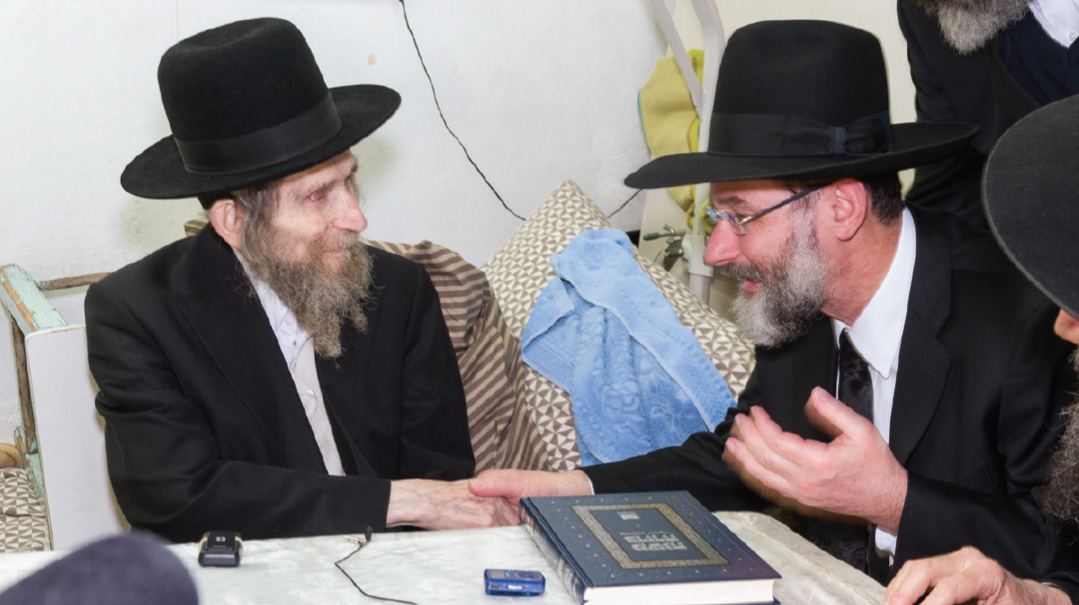
With Rav Aharon Leib Steinman
Going It Alone
The Israeli sojourn ended with the Hofstedters moving back to Toronto, where Reb Dovid joined the family real estate business.
Along with his other siblings, he learned the ropes of managing H&R’s diverse commercial and residential portfolio.
At the same time, he was noticing a gap in the learning market: many of his generation had gone through yeshivah and then kollel, but when they entered the business world, their learning either fell victim to time pressures or lost its vitality.
It was only a few years later, when he went his own way in business, that he made his move.
Sandy Hofstedter divided up his company, and his third son went solo, founding Davpart, a real estate company, in 1993. Davpart started with three industrial buildings, but the company’s portfolio eventually expanded to more than 90 industrial, office, retail, and residential projects in Canada and the US.
Embarking on any new venture is risky, all the more so when playing for high stakes in the property market.
But under Reb Dovid Hofstedter’s quiet exterior clearly beats the heart of a risk-taker, because it was precisely when he needed to focus on his fledgling company that he decided to take his first steps in building what became Dirshu.
“When I moved into my own offices, I wanted to have a beis medrash for people who were working,” he recalls. “The idea was to offer chavrusas and a shiur, followed by davening and coffee.”
A downtown office with a real beis medrash was new; but the real innovation was the fact that working men were to receive a monetary incentive. “We offered a stipend for joining. It wasn’t a tremendous amount of money, but it was just enough to give people that push.”
The cost of $200,000 was a huge undertaking, and Reb Dovid had to shoulder the burden alone. His parents and in-laws would likely have helped, but he didn’t want to ask them.
“My father was worried, and didn’t understand how I could undertake the commitment when I had a new business to run.”
Others weren’t worried — they thought it was a joke. “Everyone thought I was crazy. I had the backing of some prominent Toronto rabbanim, but the concept of paying people to learn and take tests made me the laughingstock of town.”
Even after a quarter-century, the derision is etched on Reb Dovid Hofstedter’s mind. “It was hard to walk into shuls and see the signs for the kollel defaced and see people smirk.”
But what kept him going was his wife Shifra’s support. “She never said, ‘You’re spending too much time and money on this.’ She backed me all the way.”
And the fact that the participants were enthusiastic proved that there was a demand for his product. “It was hard to take the bizyonos, but the oilam who came loved it.”
What many people don’t know is that the Dirshu empire that grew out of the downtown office was preceded by another initiative — an effort to encourage schoolchildren to go to yeshivah.
The concept was to provide a lunch-and-learn program, with good food providing the incentive to come to a shiur. The program was born out of Reb Dovid’s own acquaintance with Toronto’s wider Jewish community back in his schooldays.
That early interest in Torah learning as part of kiruv work has continued to this day through the Acheinu organization, which features learning programs for Israeli teens from secular homes. The programs act as a feeder for yeshivos in Petach Tikvah and Modiin Illit, with a student body of 1,400.
Reb Dovid’s appetite for outreach was also whetted by close association with Rav Simcha Wasserman when the latter lived in Toronto.
“I had a wonderful relationship with Rav Simcha about 45 years ago,” he says. “He loved people, and he had a very early interest in kiruv.
“I once asked him how a son of Rav Elchonon Wasserman came to be involved in outreach, and he replied with a business metaphor. ‘In the old days,’ he said ‘when people sold things at the market, how did you know whether something was worth buying? If you see a successful businessman getting involved, then jump on the bandwagon.
“ ‘In the old days,’ Rav Simcha concluded, ‘kiruv didn’t work. Now we see from Shamayim that these tzinoros are open — we have to jump onboard.’ ”
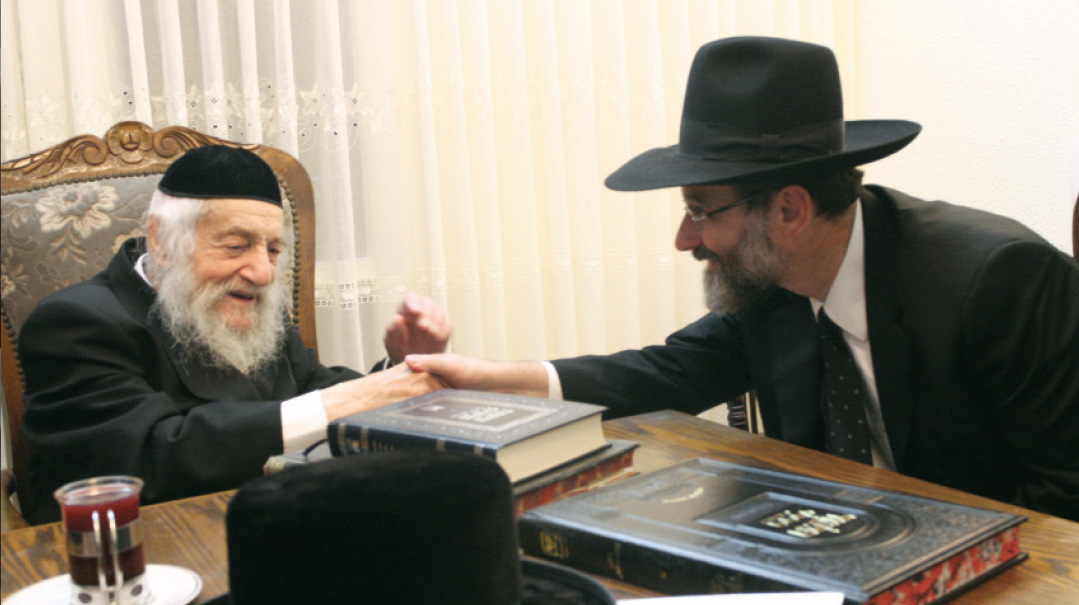
With Rav Shmuel Wosner
First Movers
There’s nothing quite like success for silencing the naysayers, and so it proved with Dirshu. At some stage, as programs expanded to different cities across America, the signs stopped being defaced, and the organization became a fixture of 21st century learning.
Then came the next storm: opposition from the commanding heights of the yeshivah world.
“Rav Baruch Mordechai Ezrachi had visited the kollel in my beis medrash one morning, looked around and saw what people were able to achieve when they learned in a structured way, with tests and incentives, and banged on the table. ‘Rabbosai!’ he said, ‘we need to bring this to the yeshivos.’ ”
In a world where mesorah is paramount, the idea of stipends, quotas, and tests in yeshivos was new. Some Israeli yeshivos adopted the new program enthusiastically, with roshei yeshivah welcoming the chance to encourage bochurim to complete the masechta. The program began as a pre-Shacharis extra learning session, and then expanded into morning and afternoon sedorim with bechinos.
But soon, a counter-movement was brewing. Two prominent roshei yeshivah went to Rav Michel Yehuda Lefkowitz — then a leading address for questions about the Torah world — asking him to speak out against changes to the traditional yeshivah curriculum.
Rav Michel Yehuda’s response surprised them: “On the contrary,” he said, “this approach is the mesorah. In Chevron, that’s how we learned — iyun in the morning, and in the afternoon, an amud of Gemara-Rashi-Tosafos daily.”
Backing of that caliber was what allowed Dirshu to take a seat of honor as part of the yeshivah world.
Years down the line, Dirshu notices are a fixture on yeshivah bulletin boards from Lakewood to Rechovot, as bochurim and avreichim make their way through masechtos or Mishnah Berurah with a stipend for passing tests.
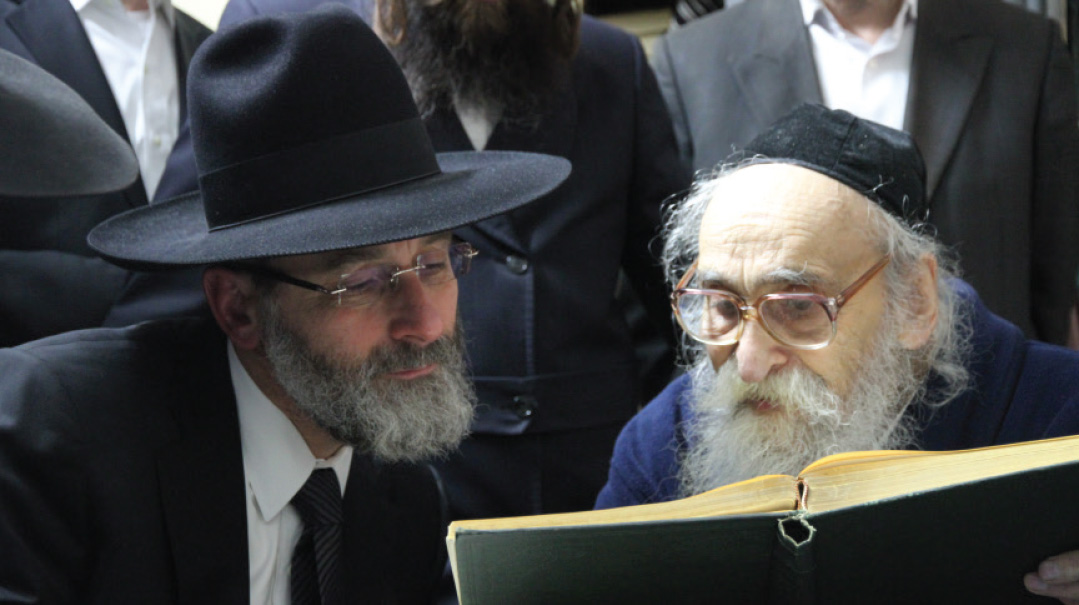
With Rav Dovid Soloveitchik
Mass Market
If Dirshu were a business, it would be classed as a multinational. The organization is a massive, well-oiled machine that operates on a global scale. The metrics are impressive: over the past quarter-century, 230,000 people have taken at least one test — some people, many more.
Unusually, the organization wears two distinct identities: it’s simultaneously mass market and elite.
Of the 14 core programs, some such as the popular Mishnah Berurah program are open to all comers. To date, the youngest entrant for testing has been all of eight years old, and the oldest 92.
In shuls from London to Budapest, Lakewood to Johannesburg, the presence of the organization’s blue-bound edition of the Chofetz Chaim’s halachic masterpiece is evidence that a Dirshu shiur is somewhere in the vicinity.
Included in that first category is the massive Daf Yomi program, which has brought Dirshu’s signature tests-and-stipends method to Rav Meir Shapiro’s enterprise.
But Dirshu has another face: its programs for a narrow band of elite lomdim are famed for their rigor.
The Kinyan Shas program, created under the direction of Rav Aharon Leib Steinman, accepts 400 avreichim for a seven-year program in which they are tested cumulatively on all of Shas. Now in its third cycle, the program is so demanding that a mere 150 participants graduate.
The entry bar for Kinyan Halacha, a program to train poskim, is also prohibitively high. But despite the caliber of the 3,000 applicants to the program, after five years only 400 graduate.
The organizational savvy needed to administer a program on five continents is unprecedented in terms of the Torah world. And like every global enterprise, a hands-on CEO is crucial.
That’s why, on the ten-minute drive to shul in the morning, Reb Dovid Hofstedter is already on the phone to Dirshu headquarters in Yerushalayim to get updates.
That same drive ends with a pre-Shacharis shiur — one of three that he gives daily. Unsurprisingly the subjects of the shiurim track Dirshu’s core programs — daily Mishnah Berurah, daf yomi, and an in-depth shiur on amud yomi. Much of his day is spent preparing for these shiurim, and writing the chiddushim that form the basis for his multi-volume Dorash Dovid series on Shas, Torah, and Moadim.
Value Added
Behind learning and Dirshu, business comes a distant third, consuming just two hours daily. But when all is said and done, those hours are crucial, because the entire multimillion-dollar enterprise still rests on narrow foundations: Reb Dovid Hofstedter and his real estate initiatives.
That gargantuan load has recently gotten heavier. When Covid hit and Canada retreated into a cycle of lockdowns and switched to working from home, the commercial real estate market plunged, meaning real difficulty for Reb Dovid Hofstedter. But somehow, the organization was able to weather the storm.
“Hashem helps in unexpected ways. For example, we’ve received an anonymous donation of a major sum of money over the last two years.”
Still, the tens of thousands whose learning is spurred on by the incentives he provides means that the veteran property investor must continue to take a hands-on role in a competitive business.
After decades at the top, he’s still innovating. A Canadian business paper recently noted that “real estate trendsetter David Hofstedter” was set to convert an imposing old building once used by the newspaper industry into a gigantic new complex. Adding 52 new floors to the original building would result in an “architectural jewel on the Toronto skyline.”
The ceremony marking the launch of the massive redevelopment featured a speech by Reb Dovid in which he touched on the theme that has motivated him through decades of building: the lesson of the survivors.
“Some 75 years ago, my parents and in-laws came to this country as survivors of the Holocaust of Europe,” he said. “They arrived here orphaned from their families and communities, scarred, broken, and penniless.
“But they had the good fortune that Canada and Toronto took them in. They were given freedom to rebuild their lives, establish families and businesses, and practice and rebuild their religion and religious institutions. This is what this project symbolizes.”
But then he moved onto a theme that he’s spoken of with increasing frequency in recent years: anti-Semitism and the need to promote greater civic harmony.
“I visualize some of the profits from this landmark project being designated to start an organization whose role it will be to combat racism and anti-Semitism in its many shapes and forms,” he said.
“Specifically today, when hatred toward others has risen with such intensity, there’s a greater need than ever to encourage and foster an environment of patience and acceptance for all.”
The reference marks Reb Dovid Hofstedter’s increasing engagement with political figures about the issues that flow directly from his core beliefs as the son of survivors: the survival of Torah Jews in a world of rampant secularism, and the survival of Jews of all types in a sea of growing hatred.
But whether he’s in the real estate office, the political arena, or his natural turf of kollel and yeshivah, there’s a remarkable consistency to the messages that he delivers, even if the idiom is different.
Asked by a real estate magazine to name the most valuable thing in his home, the property magnate didn’t blink.
“The collection of books in my study,” he replied proudly. “They’re mostly books on Jewish law and ethics.”
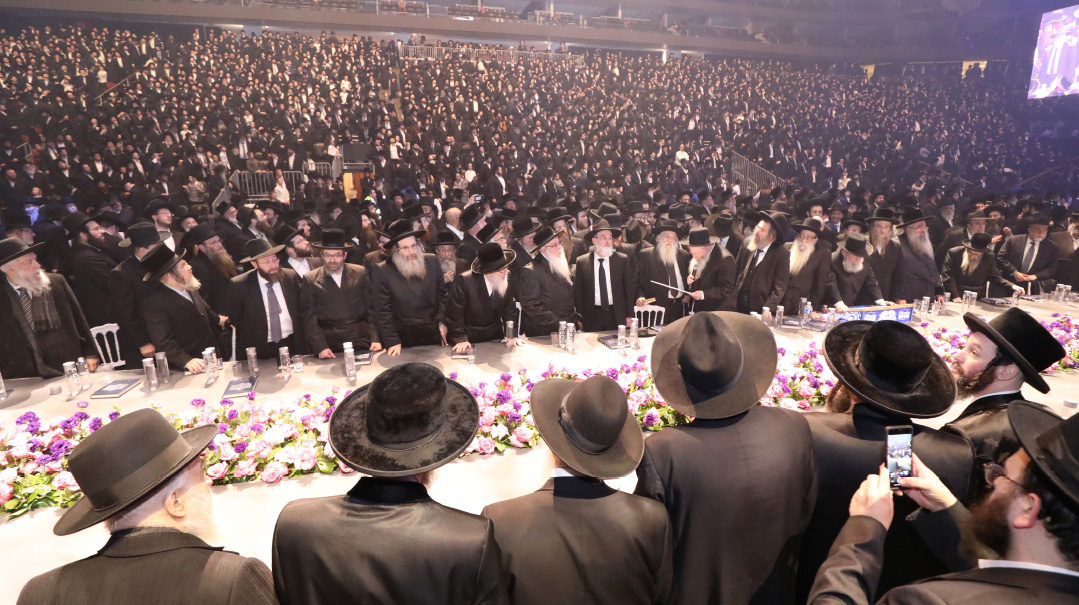
The massive Daf Yomi siyum events celebrate one of Dirshu’s signature programs
Outside In
Over four decades have passed since a young Dovid Hofstedter arrived in Eretz Yisrael to learn, and in a sense, he hasn’t left. As he sits in his Ramot home, next to neighborhoods full of avreichim, he’s still the visitor, at once a part of their world, and someone outside looking in.
It’s perhaps those fresh eyes that have allowed Reb Dovid Hofstedter to play a transformative role across the Torah world, challenging norms and bringing fresh perspective.
Inevitably, the decades-long quest to ignite the spark of learning has been a learning experience of its own.
“I’ve become a fundamentally different person than I would have been had I not taken on that first goal,” he says. “A Yid has all kinds of massive kochos waiting to be discovered.”
And that, he says, reverting back to his greatest role models, was the lesson of his parents, whose own dedication to rebuilding birthed a world they could scarcely have imagined.
“My parents were open to giving of themselves,” he says simply, “and I try to live with their sense of shlichus.” —
(Originally featured in Mishpacha, Issue 941)
Oops! We could not locate your form.







